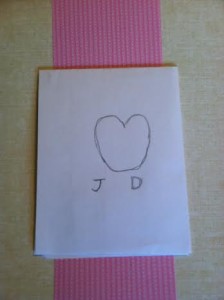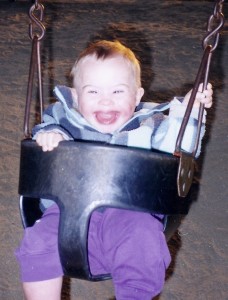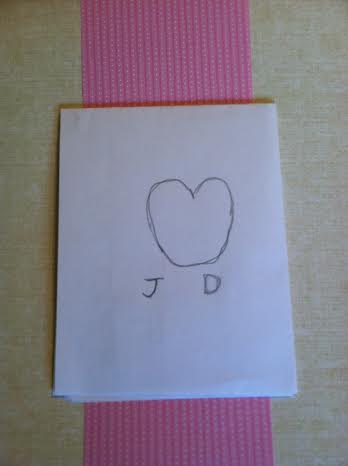What is beautiful? I have taken some beautiful photographs, but, of course, what is beautiful to one may not be so interesting to another. This week my husband and I were in the car with our 19 year old Down syndrome son. As usual he had his coloring with him and he handed us over a Valentine he had made. It was just a white piece of paper folded in quarters with a pencil drawing of a heart and two letters. He said with glee: “For you two! . . . J. and D.!”
It was beautiful.
 For him to have put the letters for “Jane” and “Daddy” made us smile. So many things he does make us smile that probably wouldn’t seem amusing to anyone else.
For him to have put the letters for “Jane” and “Daddy” made us smile. So many things he does make us smile that probably wouldn’t seem amusing to anyone else.
There is more than one way to see anything. A prime example is divergent perspectives on a walk that Joey and I took together on a warm spring day many years ago . . . I thought I’d just get us out of the house for some air and exercise by going for a pleasant little walk down the street with him. We didn’t go 2 inches at a time that he wouldn’t go off to examine some weed growing in a concrete crack or pretend to be running into someone’s trash can and insist I be very animated in my surprise and alarm at every–single–one–of–them (which is something we do, but please, every 6 feet?) Stopping and starting, we went about four houses till I ended up entirely frustrated and desperate to get back home. This wasn’t exercise, and it wasn’t very pleasant!
As we approached my relief of our open garage door, he threw his glasses into some nearby bushes, which was not at all a new behavior. And our search on hands and knees brought no positive result, which was also not at all new, and as you might guess, can get a little expensive. I was hot, I was exasperated; I walked in our back door thinking “I’m never doing that again.” We ended up in our separate corners of the house, but an hour or so later I passed by the open doorway where he was in the family room. He didn’t so much as look up but after I’d gone by, through the door behind, I heard the quiet words: “Thank you walk Mommy.”
Oh dear! He’d had the time of his life. For him, it was a beautiful day, the world was full of interesting things, and my attention had apparently been thrilling. That surely was a different way of seeing our outing. Talk about the eye of the beholder . . . it was required of me to re-see the beauty of that event. (And FYI, if you go out after dark with a flashlight you can usually find eyeglasses amid foliage.)
In a deeper thought about what is beautiful, I recall reading an article at the time of my son’s infancy about parents of Down syndrome children using surgery to change the facial features of their child. What a concept. Initially it is not impossible to see the side of the argument that says anything closer to “normalcy” might be a good thing, but would I change his face with surgery? The parents in the article felt like their children would be treated more normally if they looked normal. But if you are being treated normally, people are going to expect normal behavior. They likely aren’t going to get that, so is it fair, to have normal expectations placed on someone without that capacity? I didn’t know about all that, but I also just couldn’t imaging subjecting a child to those surgeries.
I’ll admit that at first it was challenging to consider the prospect of my son having such a different  appearance from other children. But like all the other unknowns with having a Down syndrome child, the answers arrive. Familiarity is probably the first thing that took any wondering away, and I think the end of it came for us in the same brief amount of time – with his smile.
appearance from other children. But like all the other unknowns with having a Down syndrome child, the answers arrive. Familiarity is probably the first thing that took any wondering away, and I think the end of it came for us in the same brief amount of time – with his smile.
To us his face is beautiful.
His look is the look of our son, noticeable as his differences may be, we wouldn’t want to change him.
That said, there’s one more twist . . . I believe that after our death here we will live again with our family members in eternity. We expect our resurrected selves to be in the prime of life and with a “perfect frame” (Book of Mormon, Alma 40:23). I remarked once to my husband that it might be amazing when “one day someone with a face I don’t recognize will come up to me and say ‘Mom! It’s Joe!’” to which my husband replied with a smile, “Maybe we’ll all look like him.” Well, at least we do have to admit we don’t know the standard of beauty in heaven . . . or perhaps we did know him before we were all born and we will recognize him later, but whatever . . . once he’s down to only two of that 21st chromosome he will look different and I have to suppose that that face will be beautiful to me too.
When my son was small and people in a grocery store or some random place would tell me I had a cute baby, I would thank them and add “He’s Down syndrome.” Maybe I felt like they had a right to know in case they might want to take it back upon full disclosure, but they always looked at me quizzically while saying “I know.” All children are beautiful, ages 2, 3, or 4, but about 5 it seems our own children stay that way while others begin to fade, except nieces and nephews, but then our overall perception of inherent beauty dilutes out after that and perhaps due to the loss of familiarity, we get a lot more picky about what we think pleases the eye.
So my understanding of what is beautiful might be a bit muddled now compared to the mass of society, but I think my son has helped me learn that there is no firm definition of beautiful, no solid defining parameters. A single piece of paper with a couple of folds and some letters . . . events that don’t go as anticipated . . . eyes that look in different directions (but that recognize me), whether they belong to my son or someone else’s, every person, every thing, can be beautiful.
About Jane Thurston
Twitter •





